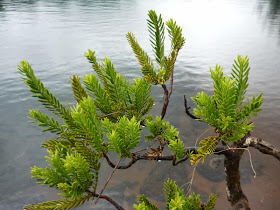 |
| Retrophyllum minus is native to New Caledonia and has adapted perfectly to living in water. It is listed as endangered in the Red List [Credit: © RUB/Knopf] |
"The distribution ranges of many Podocarpaceae are very small and often inhabited by only a few scattered individuals -- unlike our native European conifer forests that cover large areas," says Dr Patrick Knopf from the RUB Department of Evolution and Biodiversity of Plants. "There are only about ten individuals left of one species native to Fiji." In order to protect the few rare representatives of the endangered species, it is necessary to identify the species first. "In case of Podocarpaceae, it is difficult or even impossible to identify them only by their appearance," explains the RUB biologist Dr Christian Schulz. "That's why we've launched the DNA barcoding project."
Propagating and exchanging of endangered species
The researchers from Bochum collected 320 individuals from 145 Podocarpaceae species on field trips to South America, South-East Asia, Australia, New Caledonia and Fiji. At the Botanical Garden's Pfizer Plant Research Laboratory, they worked with Garden scientist Dr. Damon Little to generate DNA barcodes for all of the individuals, which they subsequently provided on the online platform "GenBank." In addition, they created a living Podocarpaceae collection in the Botanic Garden of the Ruhr-Universität which promotes the protection of rare and endangered species. The Bochum team propagate the species and pass them on to other botanic gardens worldwide.
Relevance in the timber industry and cancer research
Podocarpaceae constitute the second-largest conifer family. They grow mainly in mountainous regions in the Southern hemisphere. The timber of many of the 198 species is of great economic interest because of its excellent insect and fungus resistance. Certain substances in their leaves, moreover, are playing an increasingly important role in cancer research. The Red List of Threatened Species (IUCN) currently includes 27 Podocarpaceae species. In total, 86 species are endangered.

Dr Patrick Knopf from the RUB Department of Evolution and Biodiversity of Plants.Tennessee Wholesale Nursery
ReplyDelete